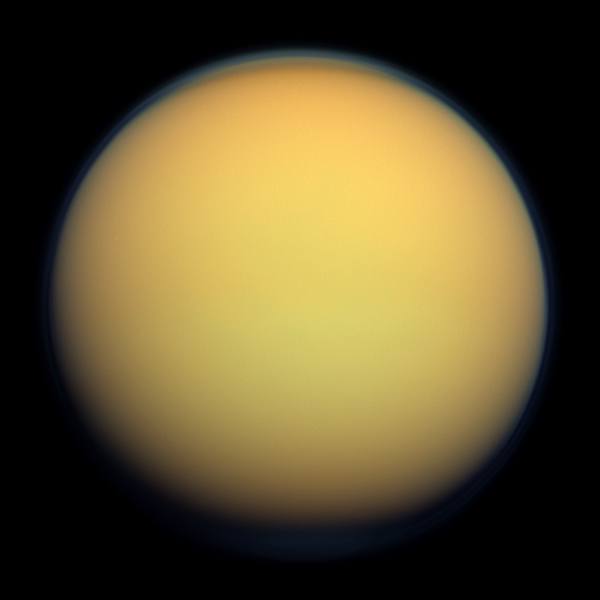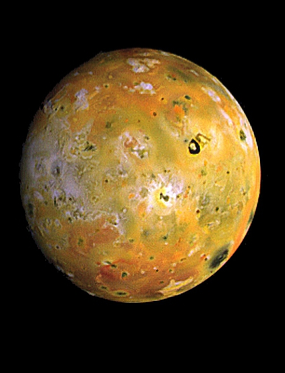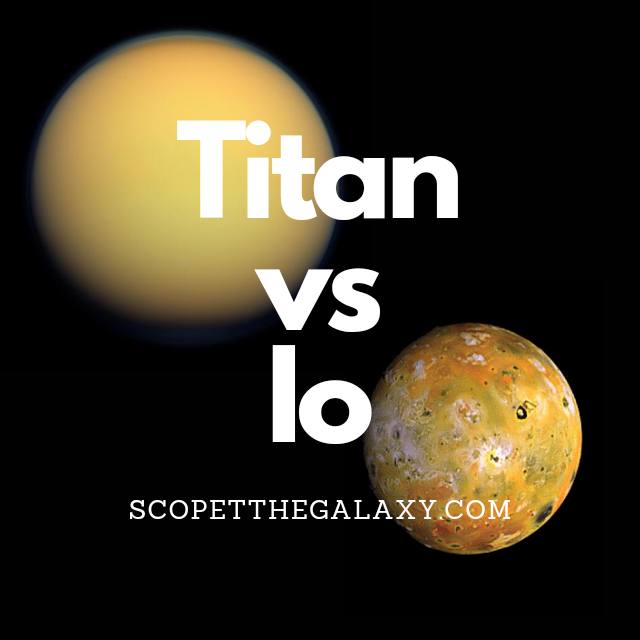*This post may contain affiliate links. This means we may make a commission if you purchase an item using one of our links*
The main differences between Titan and Io is that Titan is the 2nd largest moon with a diameter of 5,150km whilst Io is 4th with a diameter of 3,643km, Titan orbits Saturn whilst Io orbits Jupiter and that Titan has a very thick atmosphere with a water cycle similar to that of Earth whereas Io is the most volcanically active object in our solar system.
There are a variety of other differences between the two so, continue reading for a more detailed breakdown on Titan and Io along with their similarities and differences below.
What Is The Moon Titan?
Table of Contents

Titan is Saturn’s largest moon and the second biggest moon in the entire solar system, with a diameter of 5,150km. This would make it even larger than the planet Mercury which is only 4,879km, and significantly larger than Pluto also.
As a result, Titan’s gravitational strength stands at around 1.352 m/s²
It is the only natural satellite in our solar system that is composed similarly to Earth, where it has a thick atmosphere (1.19 times that of Earth) made primarily of nitrogen (95%) along with smaller amounts of methane (5%).
It has rivers and lakes on its surface along with a water cycle very similar to that of Earth, where essentially water evaporates and eventually lands on the satellites surface.
Therefore, much like Earth, Titan has a terrestrial based body but, there is a difference in their atmospheric pressure. The pressure on Titan’s surface is around 60% greater than that of Earth’s surface but, it isn’t nearly as dense.
Nevertheless, it is still far denser than most other bodies at 1.88 g/cm³. As a result, Titan’s mass is 1.345×10^23 kg.
In regards to its temperature, Titan is on the colder side where it averages around -179 degrees Celsius whilst its core’s temperature is actually very cold in comparison to other entities falling between 226 – 526 degrees Celsius.
As Saturn is the 6th farthest planet from the Sun, it will take Titan roughly the same amount of time to orbit the Sun, which would fall around 29.4 years.
It takes Titan 15 days and 22 hours to orbit Saturn. A day is 15 days and 22 hours also as it is tidally locked to the gas giant.
What Is The Moon Io?

The Moon Io – also known as Jupiter I – is the third largest of the Galilean moons, which has the closest orbit to Jupiter. It is the fourth-largest moon in our solar system by size – with a diameter of 3,643km – but has the highest density of all moons in the Milky Way.
In addition, Io has the strongest surface gravity of all moons and the least water by atomic ratio compared to any other astronomical object in our solar system.
Perhaps the most interesting feature of this lunar body is the 400 active volcanoes on its surface, which make it the most volcanically active object in the Milky Way; some of these volcanoes can exude plumes of sulfur to a height of several hundred miles.
The reason for this intense activity is the tidal heating caused by friction in the moon’s interior. Thanks to Io’s proximity to Jupiter, it finds itself caught between the gravity of its planet plus the two nearby moons – Ganymede and Europa. And this creates extreme tidal forces.
A side effect of these tidal forces is heat, which keeps most of Io’s crust in liquid form. Because of this, the surface of Io experiences a constant state of renewal; sites once home to large craters are slowly filled with molten lava and liquid rock.
While the complete makeup of Io’s surface is not yet defined, theories suggest that its main component could be sulfur and sulfur compounds because of the varied coloring. Silicate rock could also be a likely component as it would account for the high temperatures.
Io orbits Jupiter from a distance of around 422,000km, with an orbit that takes 42.5 hours to complete. Sitting 778,000,000km from the Sun, the surface temperature of this planet sits around -130 degrees Celsius. But due to the intense volcanic activity, the lava flows can reach temperatures of 1649 degrees Celsius, which is far hotter than anything on Earth.
Similarities Between Titan And Io
As both are natural satellites, Io and Titan do share a few similarities, which includes the following:
- Both have a hotter central core.
- Both have a rocky, terrestrial surface.
- Both are spherical in shape.
- Neither have rings surrounding them.
- Both are tidally locked to their planet.
- Both orbit their planet in an elliptical pattern.
- Neither have a magnetic field.
- Neither have tectonic plates.
Differences Between Titan And Io
In regards to the differences between the two, they include the below:
- Titan is the bigger of the two with a diameter of 5,150km whilst Io has a diameter of 3,643km.
- Io orbits Jupiter whilst Titan orbits Saturn.
- Io has a very thin exosphere composed of sulfur dioxide whilst Titan’s atmosphere is 1.19 times as thick as Earth’s and is composed of nitrogen and smaller amounts of methane.
- Titan has a water cycle similar to that of Earth whilst Io does not have a water cycle.
- Io is the most volcanically active celestial body in our solar system whilst Titan is volcanically active but, not to the same degree.
- A day on Io takes 42 hours whilst a Titan day is 15 days and 22 hours.
- It takes Io 42 – 43 hours to orbit Jupiter whilst Titan orbits Saturn in 15 days and 22 hours.
- Titan orbits Saturn at an average distance of 1.2 million km whilst Io is 422,000km away from Jupiter.
- Titan’s axial tilt is 27 degrees whilst Pluto’s axial tilt is close to 0.
- Io’s average temperature is around -130 degrees Celsius whilst Titan’s average temperature is -179 degrees Celsius.
- Titan’s density is 1.88 g/cm³ whilst Io’s density is 3.53 g/cm³.
- Titan’s mass is 1.345×10^23 kg whilst Io’s mass is 8.93 × 10^22 kg.
- Io’s gravitational strength is 1.796 m/s² whilst Titan’s is 1.352 m/s².
- Io’s density is 3.53 g/cm³ whilst Titan’s 1.88 g/cm³
Summary
Although both are natural satellites and orbit the two biggest gas giants in our solar system, their overall functionality is very different from each other.
Whether it be in regards to mass, size, the activity on their surfaces, their atmosphere’s, density, gravity and beyond, Titan and Io are easily distinguishable as they operate very uniquely from one another.

